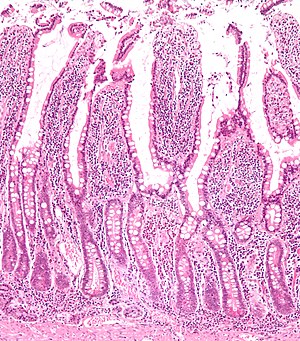
Back زغابة معوية Arabic Пыхцікі BE-X-OLD Crijevna resica BS Vellositat intestinal Catalan Klk Czech Darmzotte German Vellosidad intestinal Spanish Soolehatud Estonian پرز روده Persian Nukkalisäke Finnish
| Intestinal villus | |
|---|---|
 | |
 Section of duodenum of a cat. X 60. | |
| Details | |
| Part of | Wall of small intestine |
| System | Digestive system |
| Identifiers | |
| Latin | villi intestinales |
| TA98 | A05.6.01.011 |
| TA2 | 2941 |
| FMA | 15072 76464, 15072 |
| Anatomical terminology | |
Intestinal villi (sg.: villus) are small, finger-like projections that extend into the lumen of the small intestine. Each villus is approximately 0.5–1.6 mm in length (in humans), and has many microvilli projecting from the enterocytes of its epithelium which collectively form the striated or brush border. Each of these microvilli are about 1 μm in length, around 1000 times shorter than a single villus. The intestinal villi are much smaller than any of the circular folds in the intestine.
Villi increase the internal surface area of the intestinal walls making available a greater surface area for absorption. An increased absorptive area is useful because digested nutrients (including monosaccharide and amino acids) pass into the semipermeable villi through diffusion, which is effective only at short distances. In other words, increased surface area (in contact with the fluid in the lumen) decreases the average distance travelled by nutrient molecules, so effectiveness of diffusion increases. The villi are connected to the blood vessels so the circulating blood then carries these nutrients away.
© MMXXIII Rich X Search. We shall prevail. All rights reserved. Rich X Search